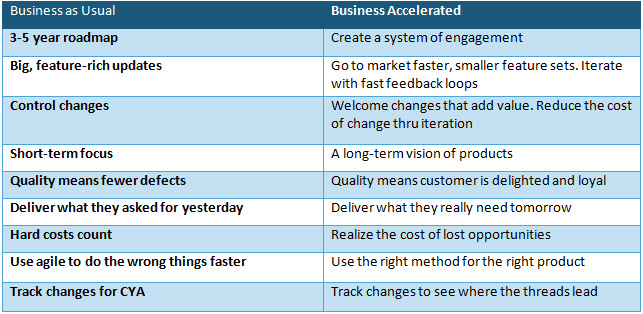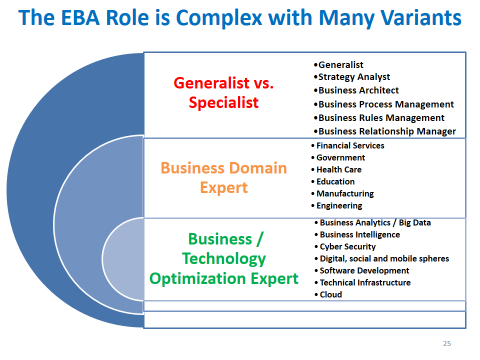
The Future is Now: The 21st Century Enterprise Business Analyst
INTRODUCTION
Business analysis is a relatively new profession. Some say it is not really a profession, but more of a line of work or collection of activities. Others say it is a discipline, a business practice that has been woefully absent in the complex world of business. The International Institute of Business Analysis defines business analysis as follows:
…the practice of enabling change in an enterprise by defining needs and recommending solutions that deliver value to stakeholders. Business analysis enables an enterprise to articulate needs and the rationale for change, and to design and describe solutions that can deliver value.
Business analysis is performed on a variety of initiatives within an enterprise. Initiatives may be strategic, tactical, or operational. Business analysis may be performed within the boundaries of a project or throughout enterprise evolution and continuous improvement. It can be used to understand the current state, to define the future state, and to determine the activities required to move from the current to the future statei.
THE BUSINESS ANALYSIS JOURNEY
20th-century business analysis has been a mostly tactical endeavor, focusing on requirements definition and management. According to anecdotal evidence I have collected over the last few years, the BA activities have been distributed something like this:

Notice the image of a baby at the center. This is intentional, and represents the early stages of business analysis. But we need to grow up fast to meet the challenges of the 21st century. While some work at the strategic level, the focus of the vast majority of the BA practitioners has been mostly:
- Management vs. leadership
- Tactical orientation vs. systems thinking
- Project and requirements management vs. complexity management
- Linear vs. adaptive
- Business as usual vs. innovation
- Project outcomes vs. business/customer value
But, the 21st century challenges us to change the way we initiate and manage change in our organizations. Traditional jobs are changing. BAs are focusing on strategy, innovation, value vs. requirements management. Project managers are focusing on complexity management vs. project management.
Organizations cannot find the talent they need to negotiate the constant change and unrelenting complexities of the 21st century. They need critical thinkers with the ability to adapt, invent, and reinvent. Collaborate, create, and innovate. Understand and leverage the complexities to harness creativity.

To remain competitive in these challenging times, CIOs realize the BA role is at the heart of future success. CIOs appreciate that BAs are in demand and will play a critical role in the future, but not the type of BAs we have today. And so, they are rebuilding the BA role. CIOs around the globe are searching their resources to find experienced and solutions focused IT and business professionals who are ready and willing to step into the leadership role of the Enterprise Business Analyst, moving from a requirements focus to a strategic solution focusii.

THE RISE OF THE ENTERPRISE BUSINESS ANALYSIS PRACTICE – IT’S ALL ABOUT VALUE
Business analysis is transforming itself before our very eyes to create better business outcomes. Some refer to it as ‘Breakthrough Business Analysis.’ The role of the enterprise business analyst (EBA) is coming into its own. The focus is clear: it’s all about value.

While not all change initiatives are complex, it is clear that the world is changing rapidly, technology advances are fast and furious, and businesses need to ‘innovate or evaporate.’ If we are not bringing about value, we should question the need for the initiative. So, what does breakthrough value-based business analysis look like?

While moderately complex projects will still need traditional BA practices focusing on requirements definition and management, these will become fewer and fewer as we transgress through the 21st century. Traditional BA practices work when not dealing with complexity, but are deficient when managing complex enterprise change initiatives.
Enterprise business analysis focuses on delivery of business value and innovation. EBAs understand the holistic nature of change; transformational change requires attention to people, process, organizations, rules, data, applications, and technologies to make up a transformational business practice. The EBA embraces business architecture and deliberate design to help temper project failure.
Realizing that a holistic view of change is both an art and a science, EBAs strike a balance between analysis and intuition, and order and disruptive change. Decision making is collaborative. Thinking is global, holistic, strategic. Complexity is leveraged to achieve creativity. Leadership is shared, diverse, expert. Teams are collaborative and high performing. Methods are adaptive, creative, agile, visual. Solutions are innovative, competitive, and sometimes unsettling and disruptive. Value is delivered early and often.
Breakthrough business analysis produces groundbreaking results. It requires different thinking and new practices and systemsiii.

THE ENTERPRISE BUSINESS ANALYST – A COMPLEX ROLE
One of the reasons the role and capabilities of the business analyst is difficult to describe is that it is a very complex function with many variants. The Generalist EBA wears many hats, from strategy analyst to business relationship manager. Whereas the specialist EBA may focus on business architecture or business rules management. At the same time, EBAs are often business domain experts so that they understand and are authorities in both the business domain and the technology supporting the business. Mostly all EBAs focus on business/technology optimization, staying current on the latest technological advances and incorporating them into the IT suite of offerings.

The next article will delve deeper into the various aspects of the EBA, describing the:
- Nature of the EBA role
- Value of the EBA role
- Special skills needed to perform the EBA role.
Don’t forget to leave your comments below.
References
i A Guide to the Business Analysis Body of Knowledge® v3, International Institute of Business Analysis, 2015
ii Mark McDonald, Ph.D., former group vice president and head of research in Gartner Executive Programs
http://blogs.gartner.com/mark_mcdonald/2012/01/30/amplifying-the-role-of-the-business-analyst/
iii Better, Smarter, Faster: Accelerating Innovation Across the Enterprise, 2013, Jama Software, Inc.
ค่า สิ โน w88
… [Trackback]
[…] Find More here to that Topic: batimes.com/articles/the-future-is-now-the-21st-century-enterprise-business-analyst/ […]